The definite policy of the United States from now on is one opposed to armed intervention.”1
This approach marked a break with the U.S. foreign policy of meddling in the domestic affairs of foreign countries in the western hemisphere in the preceding decades.
Franklin D. Roosevelt: Good Neighbor Policy
In 1933, President Franklin D. Roosevelt (1882-1945) initiated a foreign policy for the Americas called the Good Neighbor Policy. The latter represented an important change in U.S. behavior in the region. Instead of relying on force and using the military to achieve one's goals, Roosevelt wanted to foster cooperation and good relations between different countries in the Americas by using trade, economy, diplomacy, and culture.
Good Neighbor Policy: Definition
The Good Neighbor Policy (1933) was the foreign policy of Franklin D. Roosevelt's administration in Latin America.
- The purpose of the Good Neighbor Policy was non-interventionism. Cordell Hull, the U.S. Secretary of State for the Roosevelt administration, also expressed his views against interventionism in the region at the Montevideo Conference that same year. The policy was part of the general trajectory of isolationism and neutrality of the United States in the 1930s. At this time, President Roosevelt mainly focused on domestic issues, especially the recovery from the economic woes of the Great Depression (1929) by using his broad New Deal public works program.
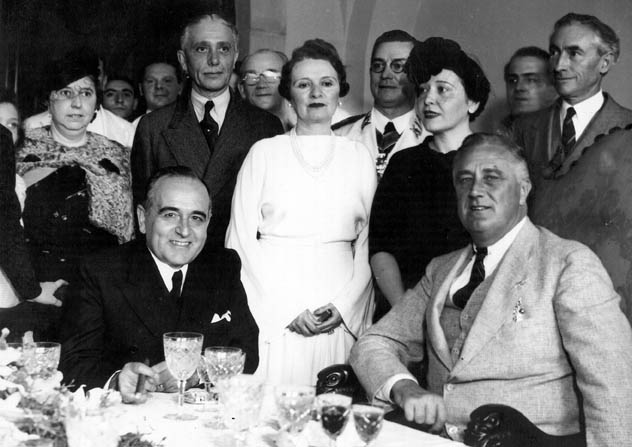
Fig. 1 - Brazilian President Getúlio Vargas and U.S. President Franklin D. Roosevelt, Rio de Janeiro, 1936.
Good Neighbor Policy: Background
The first decades of the 20th century showed a history of U.S. interventionism in the western hemisphere.
Monroe Doctrine
In the early 19th century, the United States was still a young country. In 1823, President James Monroe (1758-1831) introduced the Monroe Doctrine to Congress. This congressional statement became a cornerstone of the early U.S. foreign policy. The president sought to prevent further European colonization in the Americas. Effectively, the U.S. perceived the western hemisphere as its own sphere of influence.
A sphere of influence is a region in which one dominant country exerts more power than others and is able to influence them.
Did you know?
The immediate catalyst for the Monroe Doctrine was the fear of Spanish recolonization of Latin America. After all, a number of countries such as Mexico gained independence from Spain. At the same time, the Russian Empire has been exploring and settling parts of the Pacific Northwest region and Alaska since the mid-1700s.
Roosevelt Corollary
President Theodore Roosevelt (1858-1919) made a Congressional statement that came to be known as the Roosevelt Corollary to the Monroe Doctrine in 1904. Roosevelt believed that the United States had the right to defend its interests in the Americas by interfering in the internal politics of foreign countries. Using military means to accomplish one's goals is sometimes referred to as Big Stick Diplomacy after a well-known phrase that Roosevelt used in 1901.
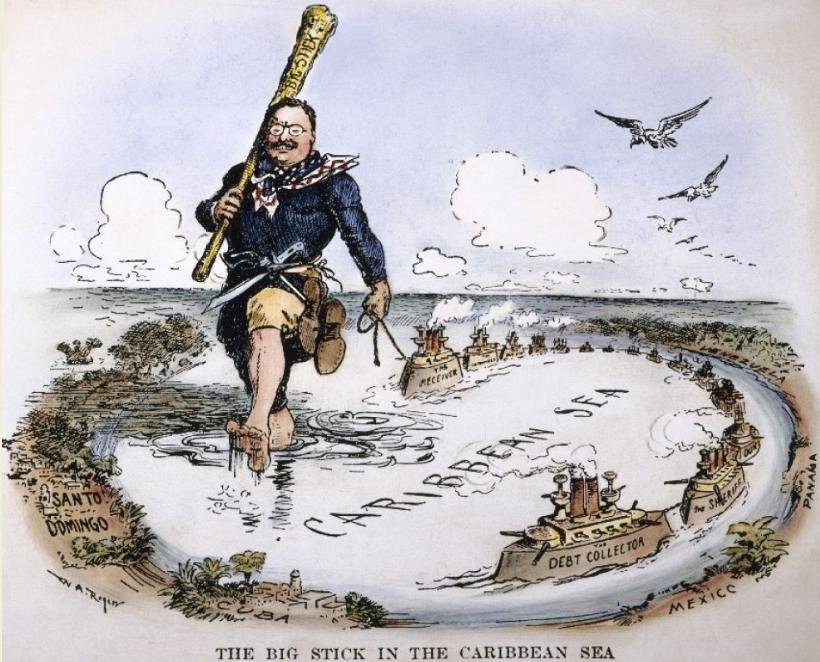
Fig. 2 - Theodore Roosevelt and his Big Stick in the Caribbean, by William Allen Rogers, 1904.
There are many examples of applying this foreign policy thinking. The U.S. supported Panama’s uprising against Columbia militarily, of which it was part in the early 1900s. After Panama’s success, the U.S. continued to back the country financially. The Americans were interested in controlling the Panama Canal which reduced the travel time between the Atlantic and the Pacific Oceans. Ultimately, the U.S. kept the canal until 1999.
Cuba was briefly a U.S. protectorate after the Spanish-American War. Despite gaining independence in 1902, Americans maintained significant business interests in that country. When Roosevelt perceived these interests as being threatened in 1906, he stated:
I am so angry with that infernal little Cuban republic that I would like to wipe its people off the face of the earth. All we have wanted from them is that they would behave themselves and be prosperous and happy so that we would not have to interfere. And now, lo and behold, they have started an utterly unjustifiable and pointless revolution and may get things into such a snarl that we have no alternative save to intervene.”2
In other words, the U.S. not only considered itself the dominant power in the region but also as the type of power that could meddle in the internal affairs of other countries.
American Imperialism
Imperialism was an important factor in American foreign policy in the first half of the 20th century, particularly after the Spanish-American War (1898).
Did you know?
The Spanish-American War took place between April 21, 1898, and December 10, 1898. This war effectively brought Spanish colonial rule to an end in Latin America. This conflict was a significant turning point for U.S. imperialism. The U.S. victory led to the acquisition of colonies in the Americas and the Pacific, such as the Philippines.
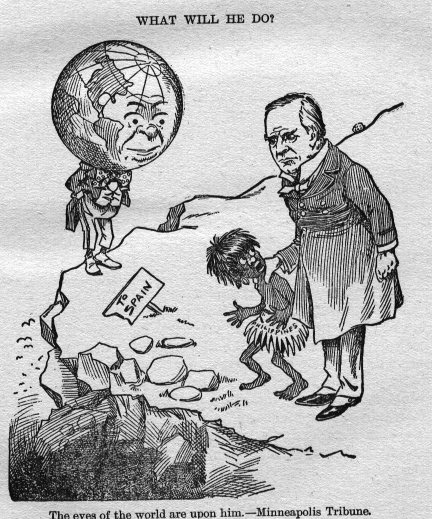
Fig. 3 - A political cartoon showing the fate of the Philippines—depicted in a racially insensitive way as a terrified child—in the Spanish-American War (1898).
Formal American colonies or protectorates in the first half of the 20th century included:
| Date | Place | Details |
| 1898-1902 | Cuba | The victory against Spain made Cuba a U.S. protectorate. In 1902, Cuba gained formal independence. However, the U.S. maintained significant business interests in this country. |
1898-1950 | Guam | The U.S. acquired Guam as a result of the Spanish-American War (1898). in 1950, Guam became an unincorporated organized territory of the United States. |
1898–1946 | Philippines | The Philippines became a U.S. colony after the Spanish-American War. The 1898 annexation was followed by the Philippine-American War (1899–1902). During World War II, this region was of strategic importance in the Pacific theater. In 1946, the Philippines gained independence from the U.S. |
1898-1917 | Puerto Rico | The U.S. also captured Puerto Rico after the Spanish-American War (1898). In 1917, Puerto Ricans gained U.S. citizenship so that they could serve in World War I. Today, Puerto Rico is a U.S. territory with one non-voting Congressional delegate. |
Dollar Diplomacy
The Dollar Diplomacy of the President William Howard Taft (1857-1930) administration may be considered a precedent of the Good Neighbor Policy. Taft, who led the U.S. between 1909 and 1913, preferred using economy and trade as an instrument of his foreign policy. He described Dollar Diplomacy as follows:
The diplomacy of the present administration has sought to respond to modern ideas of commercial intercourse. This policy has been characterized as substituting dollars for bullets. It is one that appeals alike to idealistic humanitarian sentiments, to the dictates of sound policy and strategy, and to legitimate commercial aims."3
Of course, in reality, the relationship between the U.S. and Latin American countries was often unequal. For example, American businesses bought up land in countries like Guatemala and were able to influence the local governments.
Good Neighbor Policy: Effects and Examples
1930s American foreign policy in Latin America affected the countries in that region in different ways. Overall, the policy succeeded in temporarily easing the tensions there. Trade between the U.S. and Latin American countries also increased.
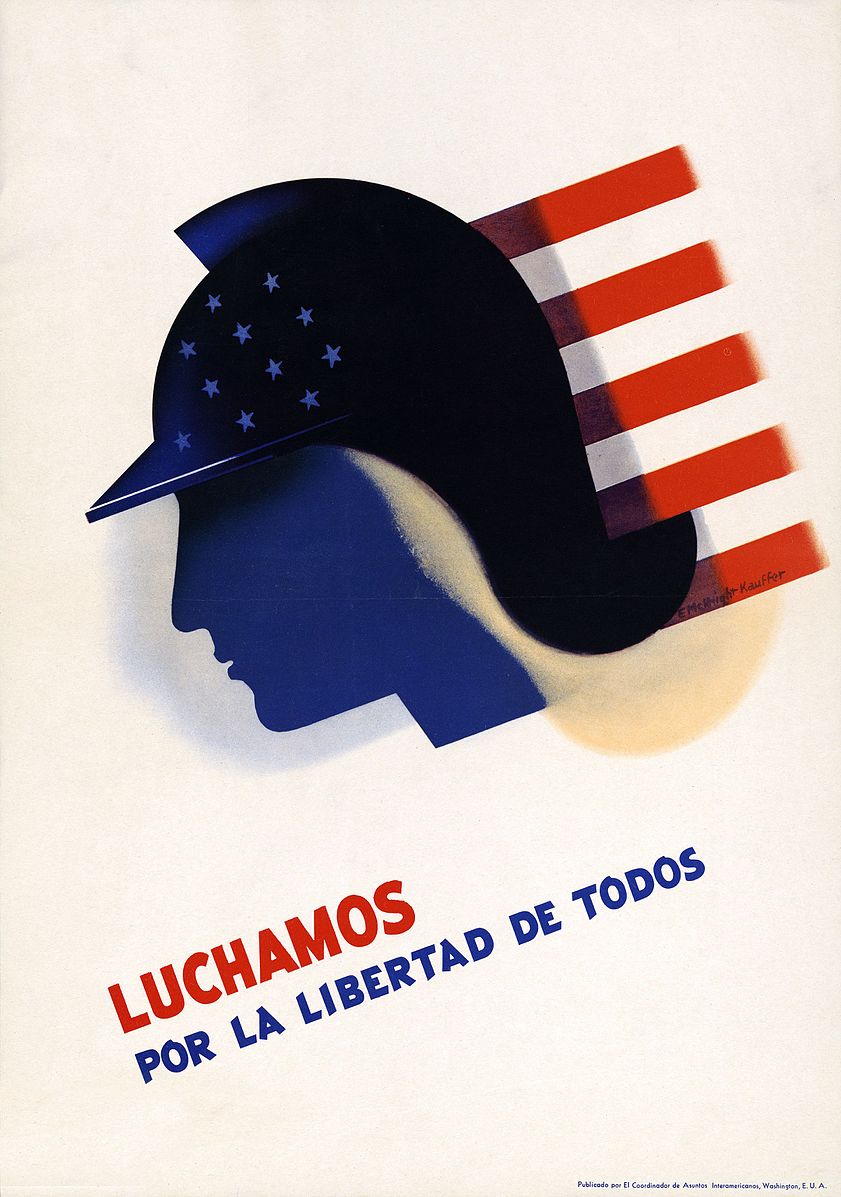
Fig. 4 - "We fight for the freedom of all,” WWII poster by Edward McKnight Kauffer promoting solidarity in the Americas.
Office of Inter-American Affairs
Eventually, the Good Neighbor Policy led to the establishment of the Office of Inter-American Affairs (1940). The purpose of this institution was to:
- improve relations in the Americas
- foster Pan-Americanism
- promote trade and economic ties
- disseminate cultural initiatives
- counter Italian and German propaganda during World War II.
Cuba
Fostering good relations with Cuba was another important area of development under the Good Neighbor Policy. The U.S. abolished the Platt Amendment in 1934.
- The Platt Amendment (1903) allowed the U.S. to intervene in Cuban affairs under the guise of protecting Cuban independence after the Spanish-American War (1898). This unequal relationship between the U.S. and Cuba was the American condition for the U.S. troops' withdrawal from the country.
However, the U.S. continued to have significant power in Cuba in the realm of trade. For instance, the U.S. sought to increase its Cuban sugar imports.
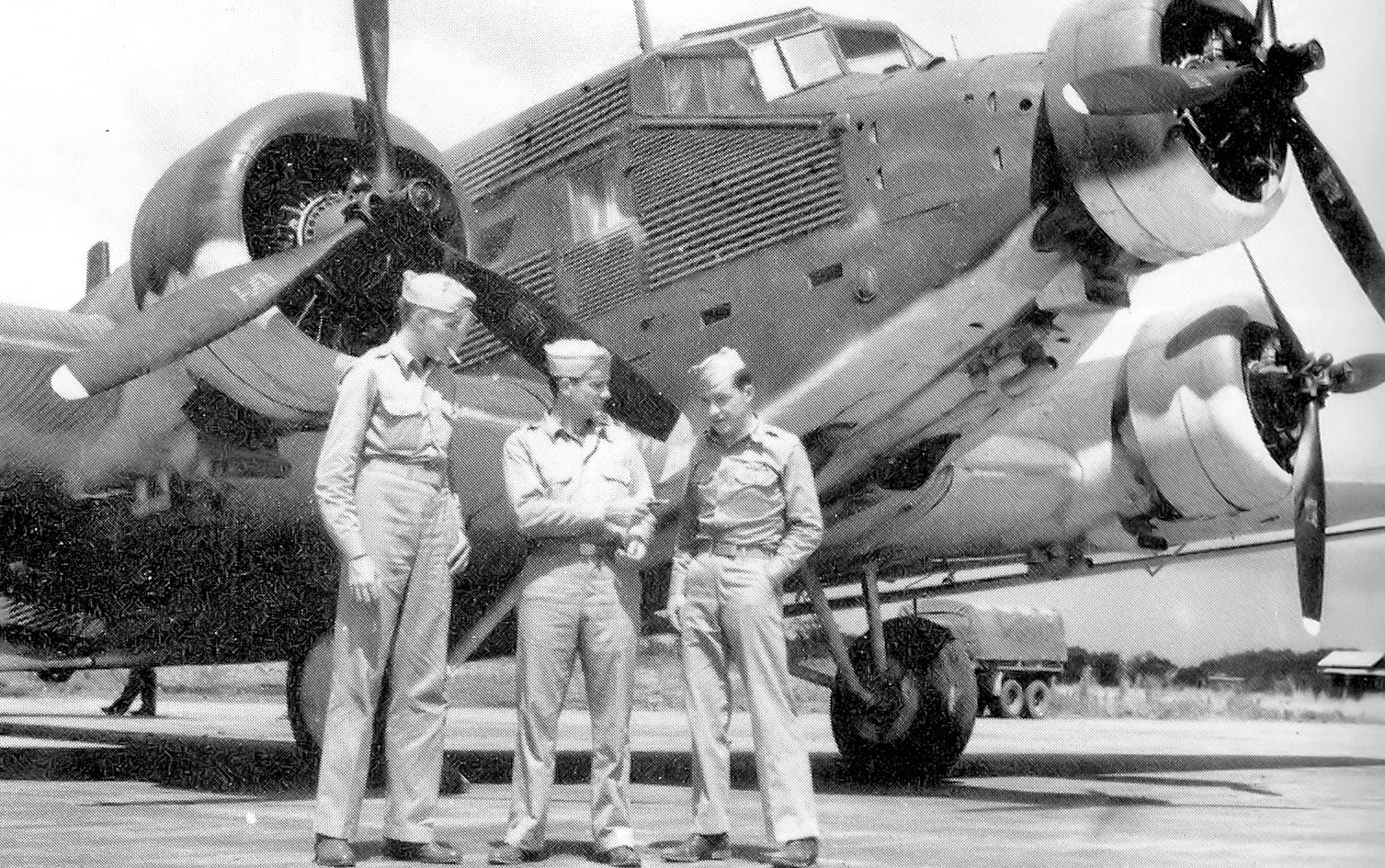
Fig. 5 - A German Junkers Ju 52/3m, confiscated by Peru and transferred to the United States Army Air Force, Panama, 1942.
Brazil
Because of its geographic location, Brazil was particularly important to both the Good Neighbor Policy and the Office of Inter-American Affairs during the Second World War. For example. The Americans focused on soft power by using film and animation to promote their interests and the war effort.
Soft power refers to using an indirect approach to influence a foreign country, such as culture, sports, and trade.
Good Neighbor Policy: Significance
The Good Neighbor Policy was an important attempt to use indirect means such as trade, economy, diplomacy, and culture to establish friendly relations in the Americas. Some historians view the latter positively because the Good Neighbor Policy:
- deescalated hostilities and temporarily halted U.S. interventionism in Latin America
- facilitated trade growth and cultural exchange
- got many Latin American countries to back the Allies during World War II.
Others argue that the relationship between the U.S. and Latin America remained unequal. The U.S. inherently interpreted the region as its own "backyard."
For example, historian David Green argues in The Containment of Latin America that the Good Neighbor Policy subscribed to economic imperialism because the autonomy of Latin American countries challenged American business interests.4
Scholars also contrast the 1930s with the Cold War period which negatively affected the western hemisphere. In 1945, the Cold War between the United States and the Soviet Union began. The U.S. subscribed to the containment policy which sought to counter its ideological rival all around the world. As a result, the Good Neighbor Policy came to an end. The U.S. increased its interventionism in Latin America.
For example, the Americans launched the Bay of Pigs invasion—a failed attempt to oust the Cuban leader Fidel Castro—in 1961.
In the 1970s and 1980s, the U.S. supported the Contras militants in Nicaragua—a group known for their significant human-rights abuses targeting civilians.
Good Neighbor Policy - Key Takeaways
- President Franklin D. Roosevelt introduced the Good Neighbor Policy for the Americas in 1933.
- The purpose of the Good Neighbor policy was to foster an amicable relationship with the neighbors of the U.S. in the western hemisphere by using such tools as trade, diplomacy, and cultural ties. The policy was moderately successful when it was implemented.
- Roosevelt's foreign policy in the Americas represented a temporary break from U.S. interventionism in the region. During the Cold War, the U.S. resumed its practice of meddling in the domestic affairs of Latin American countries.
References
- State Department, “Good Neighbor Policy, 1933,” Milestones 1921-1936, https://history.state.gov/milestones/1921-1936/good-neighbor, accessed 28 June 2022.
- Rosen, Jonathan D., Hanna S. Kassab. U.S.-Cuba Relations: Charting a New Path, Washington, DC: Lexington Books, 2016, p. 27.
- Dobson, John M. Belligerents, Brinkmanship, and the Big Stick: A Historical Encyclopedia of American Diplomatic Concepts, Santa Barbara: ABC Clio, 2009, p. 147.
- Green, David E. The Containment of Latin America: A History of the Myths and Realities of the Good Neighbor Policy, Chicago: Quadrangle Books, 1971.












